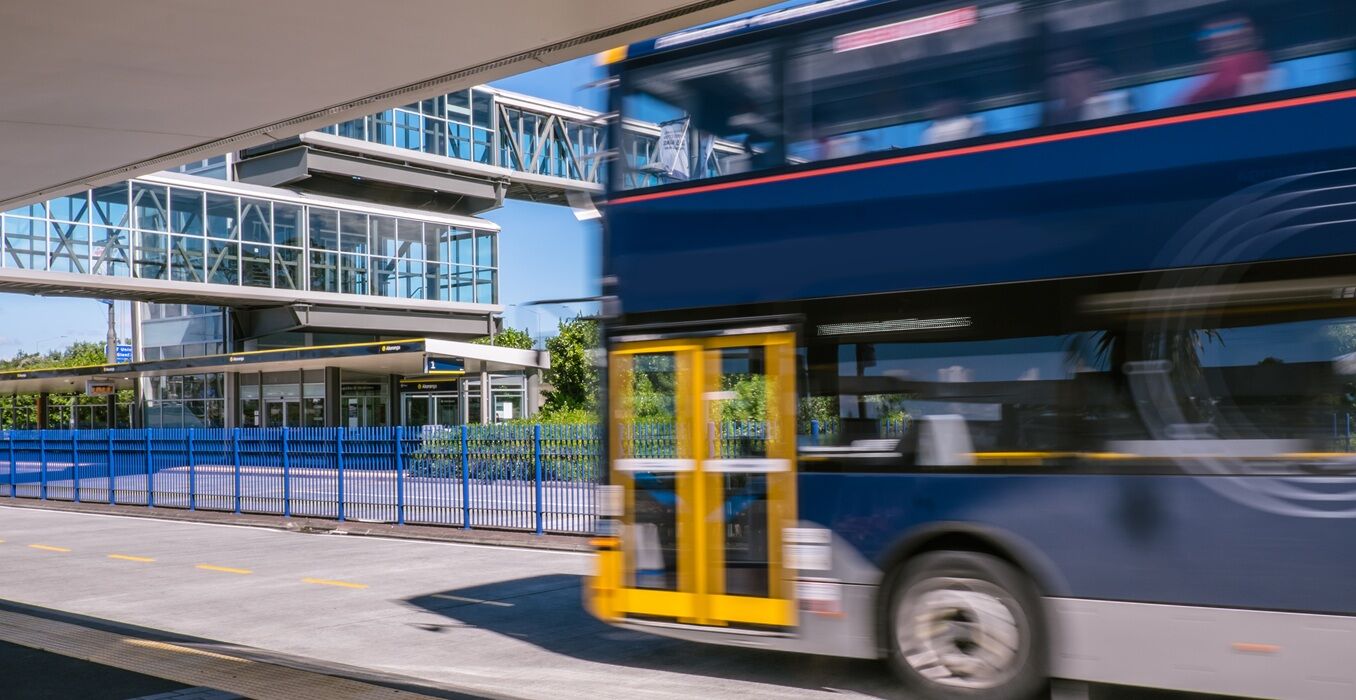Total Property -
Northwest winds of change

Auckland’s northwest is maturing as infrastructure initiatives, planning changes, and big investment in new neighbourhoods and commercial and industrial property awaken the region’s sleeping giant.
Up to 100,000 extra people are expected to be living in Northwest Auckland in the long term, and investors and developers are highly engaged in the strategically located quadrant that includes Redhills, Westgate, Hobsonville, Whenuapai, Kumeū-Huapai and Riverhead on the upper western reaches of the Waitematā Harbour. Despite strong activity and development, Bayleys general manager West Auckland, Brendan Graves believes the true potential of the northwest quadrant is yet to be fully appreciated by the wider Auckland market.
“It’s the perfect melting pot of live-zoned and future pipeline land, identified population growth, significant private and public investment in built assets and infrastructure, great retail offerings, and connectivity.
“Residential projects are quickly absorbed, occupier demand for commercial and industrial product is high, transport initiatives are progressing and there’s good value-for-money across property typologies.
“There’s definitely room for more quality office development as people want to work close to home rather than commuting to the CBD or other points of the compass. I’m of the view that if more office stock was built, businesses would follow.”
A powerhouse
Conceived and developed by New Zealand Retail Property Group (NZRPG) together with (then) Waitākere City Council, the Westgate Town Centre mixed-use precinct is at the heart of Northwest Auckland. Stuart Bode of Bayleys Northwest recalls sitting in a prefab with head of NZRPG, Mark Gunton some decades ago as he outlined the Westgate big picture.
“The site was essentially a clay pit and I didn’t fully grasp how important that landholding would become within the broader transformation of Northwest Auckland. “Westgate Town Centre now boasts New Zealand’s largest Mitre 10 and Bunnings stores, and retail hubs Westgate Shopping Centre, Westgate Lifestyle and NorthWest Shopping Centre. The country’s largest Kmart store will open in 2026 in NZRPG’s Maki Place Retail Centre, while between Mitre 10 Mega and Costco the two-level Maki Centre is nearing completion.
“Nearby, stage two of the masterplanned Northside Drive industrial business park is selling down, and other large sites now support hyperscale data centres.” Gunton explains that when NZRPG looked at the opportunity at Westgate over 28 years ago, they understood that it would not only cater for an already large population but inevitable residential growth capacity in the northwest.
“To provide for that capacity, Waitākere City Council led the delivery of the street-based town form that had the flexibility to accommodate a wide range of uses and adapt to changes and opportunities over time.
“The scale of developments at Westgate today is a testament to the blueprint the Council adopted and which we became the ‘keeper’ of following the creation of the ‘super city’.
“As a location, Westgate has amongst the highest retail spend profiles in New Zealand, and the next phase of developments we have underway will see it as the largest. Westgate has fulfilled its promise of being one of the dominant Town Centre locations in Auckland.”
NZRPG will continue to build on the retail momentum at Westgate, but also deliver on the town’s potential for office, and other mixed-use activities.
“With Westgate being a hub for Northwest Auckland’s public transport network, and given the sheer scale of residential population and business growth surrounding the town, the prospects for a wider range of development types looks strong,” says Gunton.
The catalyst for recent accelerated growth in Westgate was the sale of land to retail giant Costco in 2020. That deal and its ensuing hype reignited activity across the town centre, prompting others in the large-format retail sector to position themselves more prominently in the precinct and attracting significant new investment from emerging asset classes.
“Global data centre operators have seized the opportunity to have a presence in Westgate given its proximity to New Zealand’s largest internet peering exchange at Albany and major subsea internet cabling infrastructure,” says Bode.
“Heavyweights Microsoft and DCI are well-entrenched, while Amazon Web Services’ (AWS) centre is now under construction, adding considerable gravitas to the northwest’s capability to compete on Auckland’s commercial and industrial stage and giving Westgate a future-driven focus that other forward-thinking businesses will look to leverage.”

High-flyer
Best-known as home to the RNZAF Base Auckland, the former rural/lifestyle area of Whenuapai is being reimagined as an urban community, underscored by significant industrial business capacity.
Wesley Gerber, Bayleys Northwest director has facilitated numerous high-profile land transactions in Whenuapai and says the emerging large-scale industrial precinct will give the broader South Auckland/airport corridor a run for its money.
“Around 300ha of future industrial land in Whenuapai has been brought forward for planning/rezoning by council due to the lack of suitably zoned business land elsewhere across Auckland.
“It’s an intelligent precinct for logistics businesses given the broader connectivity via State Highways 16 and 18 and the western ring route, and will prove to be a key piece in the northwest puzzle.”
Prior to “super city” governance, Waitākere Council had identified Whenuapai as a potential residential and employment growth hub, being a natural extension to the established northwest suburbs and Westgate commercial centre.
“The private sector has proactively spearheaded zoning and private plan changes in the northwest, and Whenuapai now needs more residential development to feed into the live-work-play narrative that defines best-in-class masterplanned nodes. Whenuapai will be guided by Hobsonville Point’s example of clever, more-intensified living with high amenity,” says Gerber.
“Over the next 10 years we will see the inner northwest landscape – around Westgate, Whenuapai and Red Hills –change significantly across the retail, industrial and residential markets as developers start digging in and delivering urban outcomes.”
Residential project fast-tracked
Engineering, environmental, planning and surveying consultancy Civix is actively pursuing multiple large-format residential developments for clients keen to advance fast-track consents and private plan changes in the northwest.
One example is Aedifice Property Group’s masterplanned coastal residential project on former brickworks’ land at Limeburners Bay, Hobsonville Point which is being marketed by Bayleys.
Under Covid-19 Fast Track legislation, Civix facilitated resource consent for the comprehensive project and gained the green light for more than 400 new dwellings across the 7.5ha site in just eight weeks.
“This turnaround reflected the quality and detail of our application, demonstrated how streamlined decision-making processes can be under accelerated consenting conditions, and has allowed the development to progress at pace,” says Nick Mattison, a director and planner with Civix.
“Any site restrictions due to coastal interface and heritage overlays have been turned into assets for Limeburners Bay and the wider community, with land adjacent to the coastal marine area vested as esplanade reserve, while a no-build area will see the historic homestead retained and converted to a café, with notable trees incorporated into a future playground.”
Council priorities
Louise Mason, general manager policy Auckland Council says Westgate, Whenuapai, and Red Hills are priority areas for investment in collaboration with central government. The council’s Long-term Plan 2024-2034 acknowledges the area has substantial infrastructure investment requirements over the medium to long-term, while under the council’s Future Development Strategy (FDS), the northwest sub-region is an important growth area.
“The aim of these growth areas is to bring housing and jobs closer together to create more sustainable and vibrant sub-regions, and reducing the need to travel,” says Mason.
“Westgate is identified as the node for the northwest serving local established residential areas such as Henderson and Massey, and future urban areas around Red Hills, Whenuapai and Kumeū-Huapai.
“Westgate is at an early stage of development compared with other Auckland regional nodes and will require substantial future transport and infrastructure investment to perform well. The FDS sets out the bulk infrastructure needed to support development in future urban areas, in conjunction with the key lead infrastructure providers for water, wastewater, stormwater and transport.”
Whenuapai is expected to provide much-needed business land and employment opportunities for the northwest.
Auckland Council general manager planning and resource consents, John Duguid says in September 2016, the Whenuapai Structure Plan (WSP) was made publicly available to provide the framework to direct and inform growth and development in Whenuapai and ultimately transform the area from a semi-rural environment to an urban community.
“It was anticipated in the 2016 WSP that the area would provide between 8,100 to 10,700 dwellings depending on the density of development, 8,600 jobs and over 300 hectares of new business land over the next 10 to 20 years,” says Duguid.
“Since adopting the WSP, there have been significant legislative and policy changes, such as the National Policy Statements on Urban Development 2020 and Freshwater Management 2020 – with each having subsequent amendments – and Indigenous Biodiversity 2023.
“In addition, we have the Auckland Plan 2050 – a long-term spatial plan for Auckland to ensure growth is managed to meet the opportunities and challenges of the future, and the FDS 2023-2053, aimed at managing growth across Auckland over the next 30 years to ensure sufficient residential and business land capacity.”
In light of the above, the Auckland Council is updating the WSP and held a series of workshops in September 2024 providing an opportunity for all stakeholders to collaborate on the vision for Whenuapai.
“The aim was to better understand how the WSP could address stakeholder/landowner interests, and how any development proposals/private plan changes could ensure enhanced neighbourhood and community outcomes,” explains Duguid.
“In June 2025, following the approval of the Council’s development contributions policy, members of the public will be able to provide feedback. The WSP will then be updated and considered by the council’s Policy and Planning Committee for approval.”
Development contributions help ensure growth pays for growth and the costs of infrastructure are fairly shared between developers, ratepayers and the government, says Auckland Council group chief financial officer, Ross Tucker.
“The Council's development contributions policy was open for public consultation in 2024 following extensive analysis of growth projections and infrastructure requirements over the next 30 years. The council’s governing body will consider all feedback for a decision on 1 May 2025.”

Northwest connectivity
NZ Transport Agency Waka Kotahi (NZTA) is making progress on plans to deliver a busway alongside the Northwestern Motorway, State Highway 16, from Brigham Creek to Auckland City Centre as part of the Te Ara Hauāuru - Northwest Rapid Transit project. Local communities have expressed strong support for the project and voiced the need for improved local connections to get to the busway stations along State Highway 16.
The preferred option for a busway includes a proposed park and ride station at Brigham Creek, with stations in the west including at Westgate, Royal Road, Lincoln Road and Te Atatū. There will be further connections heading into the city centre where people will be able to seamlessly connect with the wider transport network.
“Similar to the Northern Busway alongside State Highway 1 (Northern Motorway), the project will provide quicker and more reliable journeys, and more transport choice for people in the growing northwest,” explains project director, Emma Fisk.
“NZTA is investigating ways to provide a cost-effective, value-for-money transport solution and looking into ways to build the busway in stages to provide West Aucklanders with benefits sooner, with further updates on the project expected later in the year.”
In the meantime, work is underway to deliver a new local bus station at Westgate, with NZTA expecting the station to be operational by mid-2026. Funded by the Government’s Infrastructure Reference Group (IRG), enabling works are already underway and main construction of the station is due to begin mid-this year.
The station will support Auckland Transport’s (AT) Western Express (WX1) service and AT says more public transport improvements are still to come. This includes a network of bus priority and T2 lanes to improve the speed and reliability of buses, increasing the frequency of some bus services, and introducing 40 new electric buses from April 2025 on some bus routes.